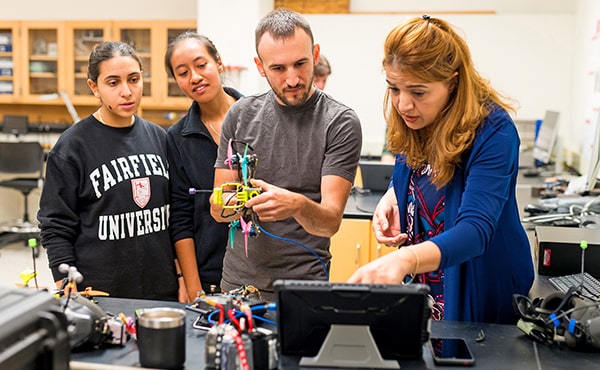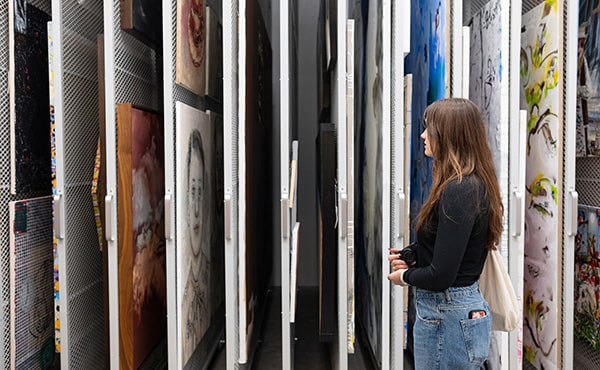Research by students and faculty is breaking new ground across schools.
The fossils were of ancient humans and the animals they were eating. They were virtually untouched. I got the feeling we might be the first humans at that spot for 1.8 million years.
— Frances L. Forrest, PhD
As Fairfield continues to advance and expand as a national, doctoral degree-granting institution, so too does its commitment to research. This past year, faculty published approximately 300 peer-reviewed works of research or scholarship, and gave more than 60 paper or poster presentations at academic conferences. The total number of new grants awarded to Fairfield exceeded $7M in federally and foundation-funded projects. The 2023 Innovative Research Symposium showcased 328 faculty-mentored student projects, 46 of which were presented at national and international conferences.
“Fairfield strives to ensure the transformative learning experiences necessary for students to meet the world as it is and will be,” said Provost Christine Siegel, PhD. “Faculty research — and student engagement in that research — is critical to that process.”
The Future of Drones: School of Engineering and Computing's Djedjiga Belfadel, PhD
One morning last summer, engineering student Gabriel Grant ’23 demonstrated a first-person view of a drone flying across campus. Wearing goggles, his fellow researchers watched as the drone zipped around, over buildings, lawns, and walkways.
The flight over Stag Country was part of an ongoing drone navigation research study by the School of Engineering and Computing, in which student researchers Lorenzo Arabia ’25, Joseph Borges ’25, Luke Conte ’25, Aldino Guadagnino ’25, and Claudia Hepfer ’25, are working under the direction of associate professor of electrical and biomedical engineering Djedjiga “Gigi” Belfadel, PhD.
Their research is focused on developing an alternative navigation system that allows drones to execute autonomous missions, even in environments that lack reliable GPS (Global Positioning System) signals.
Dr. Belfadel, whose particular area of research is drone navigation, noted that the inspiration for this research stemmed from the potential to use unmanned aerial vehicles (drones), in disaster response, defense, and entertainment.
“Our research is groundbreaking,” she said, “because it directly tackles a significant limitation in drone navigation — that is, its dependency on the availability of GPS.”
The team’s research has resulted in the development of a navigation system capable of operating in the absence of a GPS signal, an improvement in the reliability and effectiveness of drone performance, which, according to Dr. Belfadel, “becomes extremely important in disaster response or defense, where GPS signals may be unreliable or unavailable.”
“Central to this project,” she explained, “is the design of an advanced sensor fusion algorithm, which operates exclusively on data obtained from onboard sensors. This ensures continuous drone operations regardless of GPS availability. A critical aspect of our research involves testing these algorithms under real-world conditions. However, such validation necessitates tests made with commercially available drones.”
With this in mind, Dr. Belfadel and the engineering students adopted an innovative, cost-effective strategy to design and build their own test drones, with the dual purpose of creating a critical platform for testing navigation algorithms while also addressing an existing gap in the availability of affordable, U.S.-made drones for research and educational pursuits.
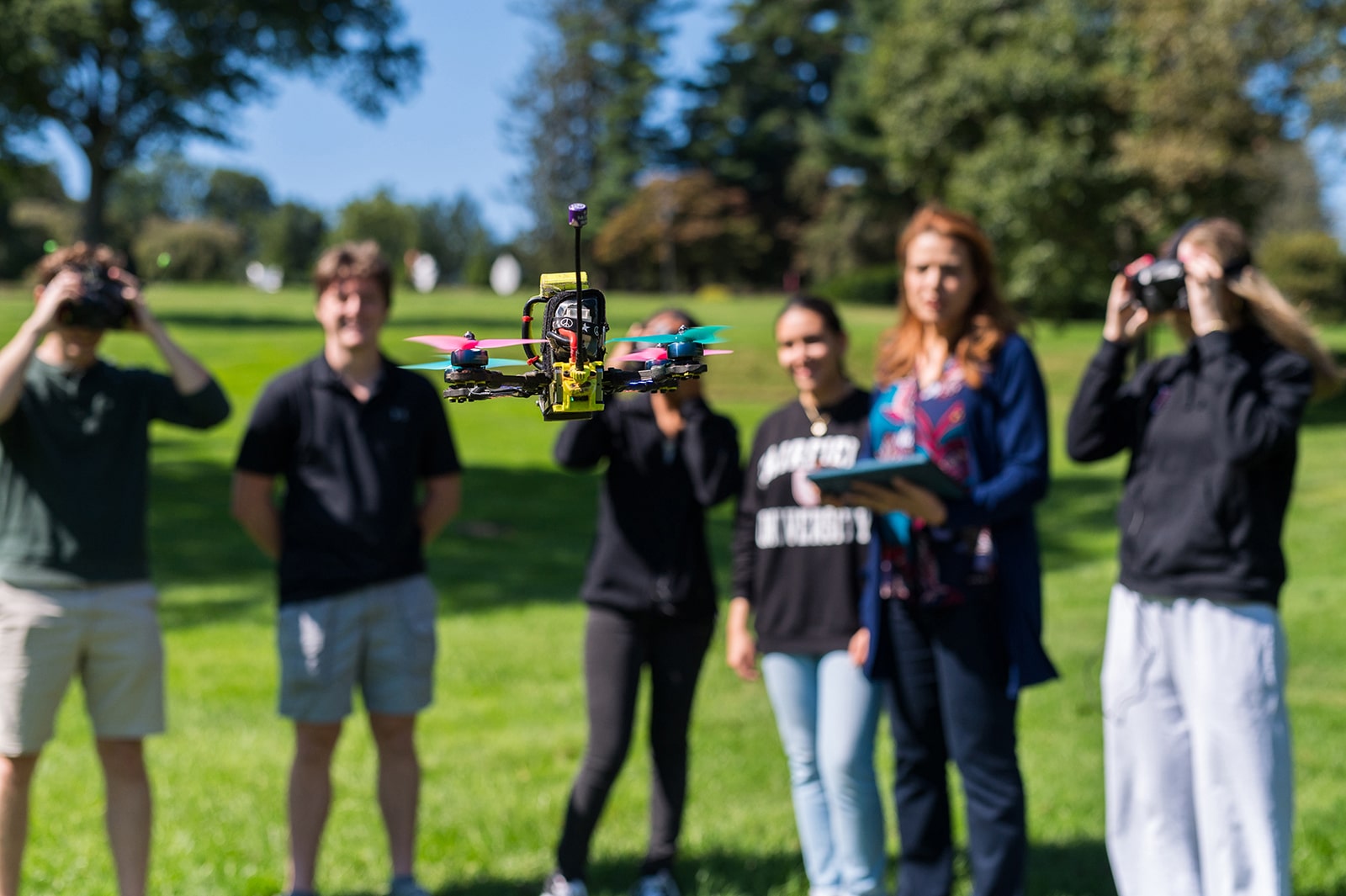
Dr. Belfadel and her team of student researchers perform maneuverability tests on the North Benson campus.
During the program’s initial phase, students went through rigorous training to obtain their drone licenses. Under Dr. Belfadel’s instruction, they then wired, soldered, and assembled two fully operational drones, printing parts on the University’s 3D printers and equipping the devices with software to collect in-flight data.
Once assembled, the team took the drones outdoors to conduct maneuverability tests, following FAA guidelines. During flight sessions, they collected data that allowed them to evaluate each drone’s performance and operational coordination. At the conclusion of every flight, the team conducted a structured debrief to discuss accomplishments and areas for improvement.
This student-led research initiative is significant, said Dr. Belfadel, in that it offers students practical, hands-on experience in UAV (Unmanned Aerial Vehicle) technology. Poised to revolutionize the use of drone navigation, Dr. Belfadel described how their research “creates a system that allows drones to operate safely, dependably, and autonomously in areas that lack GPS signals. Moreover, the drones built by the students provide a platform for gathering meaningful data, which is crucial for testing and refining our navigation algorithms.”
Studying Our Stone Age Ancestors: College of Arts & Sciences’ Frances L. Forrest, PhD
In the summer of 2019, Frances L. Forrest, PhD, assistant professor of sociology & anthropology at Fairfield, began leading a fieldwork project in the Koobi Fora region of Kenya with a group of college students.
A specialist in biological anthropology, Dr. Forrest, three years earlier as a CUNY graduate student, had been part of an international team that uncovered a trove of three-million-year-old stone tools, fossils, animal and hominin teeth at Nyayanga — another site in Kenya — which turned out to be the earliest evidence of a species using stone chopping, scraping, and cutting implements (known collectively as the Oldowan tool kit), nearly a million years earlier than previously documented.
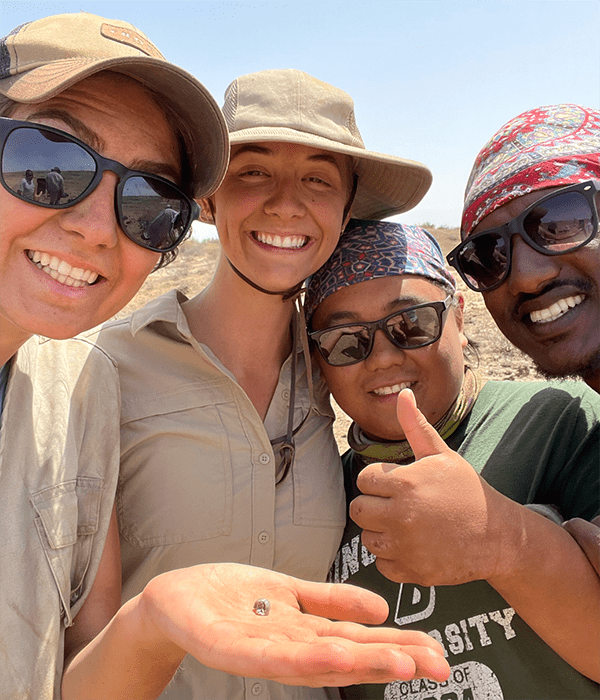
Dr. Forrest’s students hold a tooth from an ancient human species called Homo erectus, dated to approximately 1.8 million years old.
“The hominin species is closely related to us but not in the Homo genus,” said Dr. Forrest, who joined the Fairfield faculty in 2022. “This is exciting because Oldowan tools were previously associated only with our genus (Homo). We didn’t think hominins were innovative enough to use Oldowan tools and here we had evidence they may have even been creating some of their own.”
Dr. Forrest’s more recent, ongoing research project at the so-called Koobi Fora site in Kenya uncovered an assemblage of fossilized bones from almost two millions years ago, which may, in fact, prove just as groundbreaking as that earlier discovery, as it involves the roots of our human ancestors’ dietary habits dating back to the early Stone Age.
“The assemblage we discovered had an amazing combination of fossils and artifacts. There has not been a site this rich at Koobi Fora. It wasn’t just super rare, it was older than other sites, which should give us more insights into the origins of how and when our species began eating meat.”
Research teams from all over the world have been digging in and exploring Koobi Fora for decades.
Coming upon a hoard like the one discovered by Dr. Forrest and her students in such a well-trodden area was near miraculous.
“One of my students was interested in studying animal teeth to determine their age, and we were looking for a good site to conduct that research,” explained Dr. Forrest. “My translator climbed a hill to get a good look at the surrounding area. While he was up there, he came upon all these fossils just sitting there. The fossils were of ancient humans and the animals they were eating. They were virtually untouched. I got the feeling we might be the first humans at that spot for 1.8 million years.”
The project Dr. Forrest began in 2019, entitled “Zooarchaelogy at a New Hominin Locality in Koobi Fora, Kenya,” resumed in 2022 after a hiatus due to Covid, and received a major boost when she was awarded a Leakey Foundation grant in May of this year. She hopes to take a couple of Fairfield students on her expedition next summer.
The Fintech Frontier: Fairfield Dolan's Katsiaryna Bardos, PhD
In 2024, the Charles F. Dolan School of Business — currently ranked 17th nationally for graduate finance programs by U.S. News and World Report — will add a new MS in Financial Technology program. The master of science program, one of very few in the country, is being spearheaded by associate professor of finance Katsiaryna Bardos, PhD, and will bring the number of graduate programs in the business school up to seven.
Fintech, as it’s often called, is a rapidly evolving sector in the business world as corporations learn how to incorporate blockchain, cryptocurrencies, artificial intelligence, and other technologies into daily practice. In Dolan’s MS program, students will take classes offered by three different departments — finance, analytics and management — in order to better understand the scope of the fintech innovations happening almost daily. They will stay atop of trends, learning the latest in financial data modeling, algorithmic trading, and cloud-based, data-driven technologies.
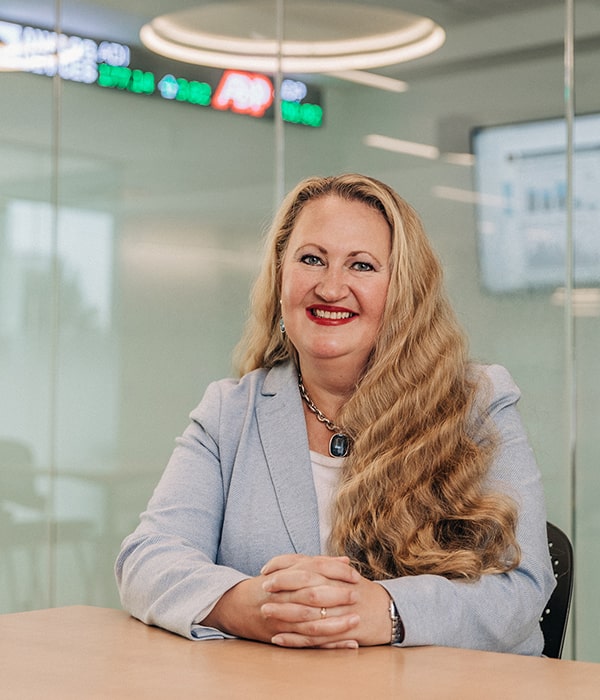
Associate Professor of Finance Katsiaryna Bardos, PhD.
“The curriculum is cutting-edge,” said Dr. Bardos, who chairs the Finance Department. “The topics we designed for the program are very much what employers are looking for now in graduates.”
Noting that “fintech is the biggest change we’ve seen [in the business world] since the invention of the internet,” Dr. Bardos continued, “along with blockchain, it will transform the world of finance as we know it.”
Like other Dolan graduate programs, the new Financial Technology program can be accessed fully online or in a hybrid format on weekends. Completion of the master’s degree will take anywhere from 9 to 12 months, depending on the number of classes a student takes per semester.
The addition of the MS in Finance Technology program is part and parcel of Dolan’s overall mission, Dr. Bardos said, emphasizing that “we want our students to be as competitive as they can be, and we want them to develop skills that are relevant.”
It’s also another way to promote the University’s Jesuit mission, she noted. Fintech can help companies make products more available and less expensive, and providing people with easier access to finances beyond traditional banking makes it possible for budding non-traditional entrepreneurs to get financing.
Because fintech is changing so quickly, Dr. Bardos said the new master’s program will rely on the expert research already being conducted by Dolan faculty members and professors of Fairfield’s other schools.
For those who aren’t sure if they should get a Master in Business Administration or a Master in Financial Technology, Bardos noted that the school is currently looking into the option of an MBA with a specialty in fintech, and offered this advice: “An MBA education offers a little bit of everything, whereas MS programs really hone into one area. It’s more of an in-depth education rather than one of breadth.”
Engineering for Nursing Research: Susan Freudzon, PhD & Christine Aloi ’12, DNP’19
Biomedical engineering student Emma Crowley ’24 held up a red trachea prototype newly constructed using the 3D printers at the Innovation Annex. This prototype was the result of a semester-long design project collaboration between the School of Engineering and Computing and the Marion Peckham Egan School of Nursing and Health Studies.
It was also the solution to an interesting dilemma for the Egan School’s assistant professor of the practice and simulation coordinator Christine Aloi ’12, DNP’19.
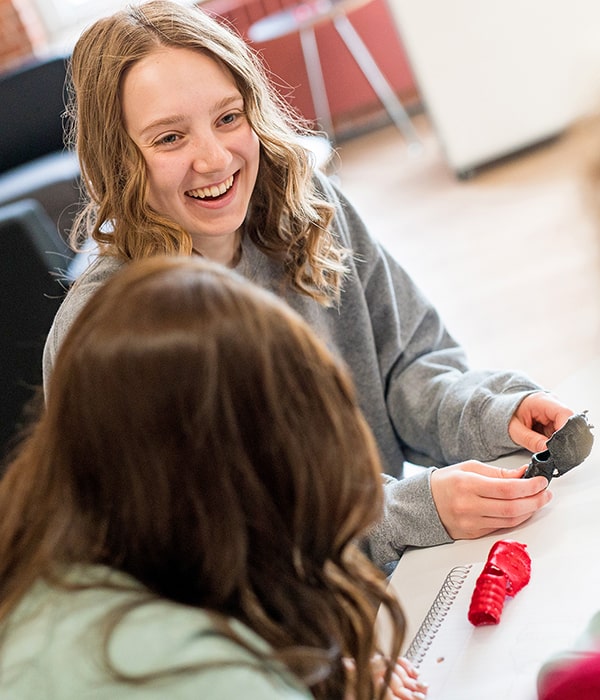
Sydney Rogers ’24 analyzes trachea prototypes.
As the Egan School continues to grow its highly competitive Doctor of Nursing Practice (DNP) Nurse Anesthesia program, explained Dr. Aloi, “One of the essential procedures a nurse anesthetist must master is a cricothyrotomy, which is an emergency surgical airway intervention used when the patient’s anatomy or medical condition makes it impossible to insert a breathing tube through the mouth.”
With an increase in the number of student nurse anesthetists in the program and only one trachea model on which to practice airway skills, it was becoming difficult for students to get the hands-on time they needed, she said, “so we began looking for an innovative solution.”
Enter the School of Engineering and Computing. Under the guidance of Biomedical Engineering program director Susan Freudzon, PhD, Biomedical Engineering Society student club copresidents Emma Crowley ’24 and Julia Kilroy ’24 (a biology major) were charged with creating an anatomically correct trachea model that could be used by Dr. Aloi’s DNP nursing students to practice their skills.
Together with biology major Sydney Rogers ’24, Crowley and Kilroy met with Dr. Aloi to examine the Egan School’s current task model. They took measurements from every angle and observed a student demonstration of the device.
A key part of the respiratory system, a human trachea is made of rings of cartilage giving it flexibility. Roughly, the trachea is four inches long and an inch wide, the size of a finger.
During their first attempt at the design, the students 3D-printed a model using standard hard plastic, but the result did not mimic the flexibility of a trachea. “It was anatomically correct, but didn’t have the flexibility the nurses would need,” noted Crowley.
They switched to a more flexible, silicone-like material called thermoplastic polyurethane, and adjusted the printer’s settings. “We had to determine how much infill, or thickness, was needed, the speed of the printing, and what kind of support to provide as the material came out of the machine,” Crowley said.
In the end, the team designed and 3D-printed four durable model tracheas, which were fitted with standard commercial tubing and a bag to mimic a functioning trachea and lung.
Dr. Freudzon predicts that this will not be the last collaboration between the two schools. “We have a couple of ideas,” she said. “Our students don’t often get to witness the immediate impact of something they’ve created, so I’m especially excited for them to see these models in use.”
Re-Imagining Motherhood and Careers: SEHD’s Evelyn Bilias Lolis, PhD
As the interim dean of the School of Education and Human Development, Evelyn Bilias Lolis, PhD, is focused on reenvisioning the future of work in her field — both through continuing to expand the school’s culture of innovation and in her new book, Re-Imagining Mothering & Career: Insights from a Time of Crisis.
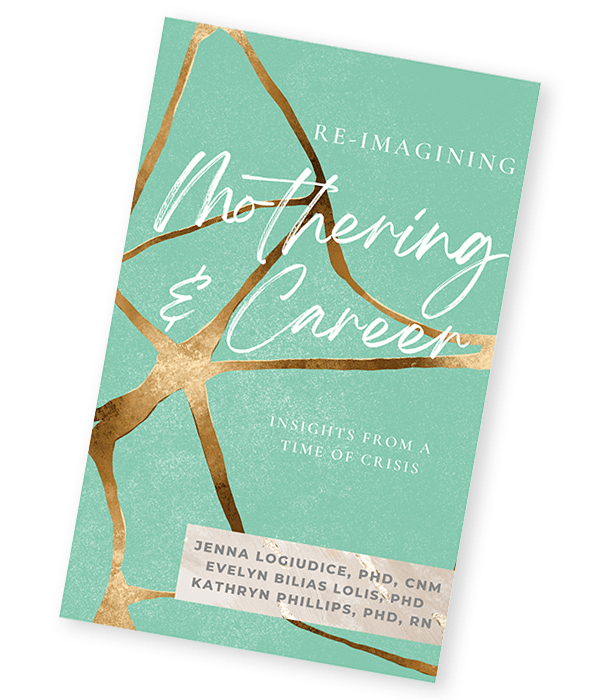
The book — co-authored by University colleagues Jenna LoGiuduce, PhD, and Kathryn Phillips, PhD, who both teach in the Egan School — is a mix of historical narrative, critical analysis and essays written by women, and as such is aimed at a broader audience. Published this past summer by Demeter Press, Re-Imagining Mothering & Career includes 33 essays contributed by women of varying ages, ethnicities, family compositions, and careers, who were asked to write about the ways in which the Covid-19 pandemic affected them.
“It is really multifaceted and multidimensional in its use,” said Dr. Bilias Lolis. “It’s not just academic. It’s meant for everyone.” CEOs and managers, for instance, could benefit from the book’s insights, to rethink their corporate cultures, she noted. “It’s very validating and empowering for women.”
Dr. Bilias Lolis and her co-authors’ interest in this topic began during the pandemic itself.
“We wanted to preserve the insights of that time and use them as an impetus for change,” Dr. Bilias Lolis said. “We support a burn-out culture, especially in the U.S., but what Covid has done for us is it pulled the curtain back on mental health. We all realized that we share this common humanity.”
This awareness especially impacts working women, she said. “You have responsibilities in the home and at work and in your career, and society expects you to be in one setting and pretend like the other one doesn’t exist temporarily, and that’s never the case. You’re always in two places at once. The expectation in each setting is that you perform as if the other compartment is not there at all.”
Rethinking how people simultaneously manage different, often competing, roles is a focus of the School of Education and Human Development’s always-evolving vision, said Dr. Bilias Lolis. Recognizing students’ complex lives — juggling work, self-care, and family — the school offers online and low-residency advanced degree programs as a way to grow professionally.
Additionally, the school is looking at other ways to prepare students that are both cost-effective and time efficient, without sacrificing Fairfield’s academic quality. “We know we produce high-caliber teachers and mental health professionals,” Dr. Bilias Lolis said, “but we want to be cognizant and sensitive to the time and money involved. We’re doing a deep dive into that area. Our school’s mission now is to help recover and reinvigorate the needs of the education and mental health fields as they recover and grow,” she added. “We’re innovating in our ability to meet students who want to serve in these fields and in these national critical-shortage areas.”
